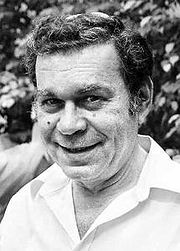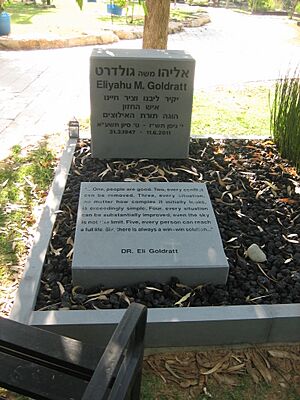Eliyahu M. Goldratt facts for kids
Quick facts for kids
Eliyahu M. Goldratt
|
|
|---|---|
 |
|
| Born | March 31, 1947 |
| Died | June 11, 2011 (aged 64) |
| Nationality | Israeli |
| Known for | Theory of constraints Cause and effect thinking Slayer of paradigms |
| Scientific career | |
| Fields | Theory of constraints Operations research Organizational psychology Management science Education |
Eliyahu Moshe Goldratt (born March 31, 1947 – died June 11, 2011) was a smart Israeli thinker. He helped businesses and organizations work much better. He created many important ideas, like the Theory of Constraints (TOC). This theory helps people find and fix the biggest problems that stop a system from reaching its goals.
Goldratt wrote several books, often as exciting stories called "business novels." These books showed how his ideas could be used in factories, engineering, and other business areas. His main goal was to help people think clearly and solve problems in a logical way.
In his famous book, The Goal, the main character manages a factory that is having trouble. Goldratt explains that in any system, there's usually one main thing that slows everything down. This is called the "constraint" or "bottleneck." When you fix that one problem, another part of the system might become the new bottleneck. Goldratt's stories often show how to find this main problem and improve it. He also taught that it's okay for some parts of a system to not be working at full speed. This can actually help the most important parts run smoothly.
Contents
His Life Story
Eliyahu Goldratt was born in 1947 in what was then British Mandatory Palestine. This was one year before Israel became a modern country. He came from a family of religious leaders.
He studied at Tel Aviv University and Bar-Ilan University in Israel. He earned his bachelor's, master's, and PhD degrees there. Goldratt passed away in his home in Israel on June 11, 2011, because of lung cancer.
Goldratt's Work and Ideas
Starting with Creative Output
After helping some factories in Israel, Goldratt left university life. He joined a company called Creative Output. This company made and sold a special computer program called Optimized Production Technology (OPT). This program was one of the first to help factories plan their work better. It made sure that machines didn't get overloaded.
Goldratt noticed something important while working there. Even with the great software, some companies weren't getting the best results. He realized that old habits and ways of thinking were still causing problems. People needed to change their mindset, not just use new software.
Writing The Goal
To help people change their thinking, Goldratt decided to write a book. It took him 13 months to write The Goal. At first, many publishers didn't want to print it. But with help from a small publisher, the book came out and became a huge success!
Goldratt saw that many people were using the ideas from his book without even buying the software. This caused some tension at Creative Output. Goldratt wanted to help people understand how to use his ideas directly. He developed a method called Drum-Buffer-Rope. He also wrote another book, The Race, to explain more of his concepts. He even created a game to teach people how to manage production better.
Goldratt wanted Creative Output to focus more on teaching and consulting. But the company's owners wanted to sell more software. Because of these disagreements, Goldratt eventually left the company.
The Goldratt Institute Years
Around 1985, after leaving Creative Output, Goldratt started a new organization. He named it the Avraham Y. Goldratt Institute (AGI), after his father. His goal was to share the Theory of Constraints all over the world.
During his time at AGI, Goldratt kept developing TOC. He created new tools like the Thinking Processes (introduced in 1991). He also developed Critical Chain Project Management, which helps manage big projects more effectively. His ideas started to be used in many different areas, not just factories.
In 1997, Goldratt decided to retire from the Institute. He did this before his 50th birthday, as he had planned.
The Goldratt Group
In the early 2000s, Goldratt started a new group called the Goldratt Group. He continued to develop TOC even further. He supported new ways to use TOC in education, healthcare, and even for personal improvement. He also wrote another book called The Choice.
His Books
Business Novels
Goldratt wrote many books that told stories to explain his ideas.
- The Goal: A Process of Ongoing Improvement (1984): This book introduces the main ideas of TOC. It shows how to improve organizations step-by-step.
- It's Not Luck (1994): This book applies TOC to marketing, how products are sent out, and business plans. It shows how to use thinking tools to solve problems.
- Critical Chain (1997): This book uses TOC for managing projects. It introduces the Critical Chain method, which helps projects finish faster.
- Necessary But Not Sufficient (2000): This book looks at how TOC can improve computer systems used in businesses.
- Late Night Discussions on the Theory of Constraints (1998)
- Isn't It Obvious? (2009): This story is about a husband and wife who work in a retail store. They use TOC ideas to solve a big problem and find success.
Nonfiction Books
Goldratt also wrote books that directly explained his theories.
- The Race (1986): This book explains the Drum-Buffer-Rope system, which helps manage production.
- Essays on the Theory of Constraints (1987)
- What is this Thing Called Theory of Constraints (1990): This book explains the five steps to keep improving things. It also covers the basics of his thinking processes.
- The Haystack Syndrome: Sifting Information Out of the Data Ocean (1991): This book explores how to measure performance and turn data into useful information.
- Production the TOC Way (Revised Edition) (2003)
- The Choice (2008): This book shares Goldratt's main beliefs through conversations with his daughter, Efrat.
Plays
- UnCommon Sense (1995): Goldratt also wrote a play.
See also
 In Spanish: Eliyahu M. Goldratt para niños
In Spanish: Eliyahu M. Goldratt para niños
- Business fable
- Organizational capital


